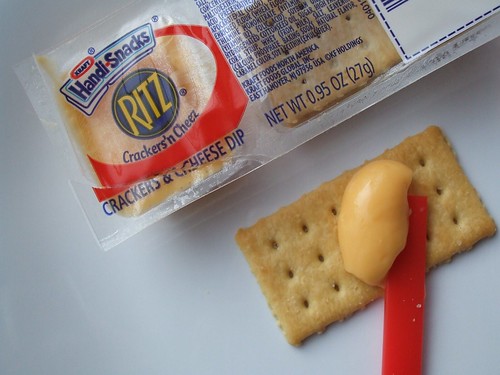
Some mysteries are better left unsolved. For example, it baffles my mind to ponder exactly what part of the cheese becomes the semi-gelatinous room-temperature no-refrigeration-required goo in the Handi-Snacks conveniently compartmentalized tub. The more I think about it, the more my brain yearns to burst from its enskullment and lay twitching on the floor, exhausted and defeated. Luckily, I've never given it that much thought.
Dunkable snacks were all the rage in the 90s. Dunkaroos cornered the sweet sector of the market, but the savory had yet to be conquered in a snack dunking tour de force. Luckily, Nabisco (later Kraft) was there to step in and show us the way to salty dunkable goodness. With mystery cheese. Really, just incredibly mysterious. I'm starting to get a headache again contemplating its very existence, so I think I'll just go on pretending that's a natural state of cheese. Okay, good, good. I'm back at cheese-pondering baseline again. Whew. Close one there.
Handi-Snacks were a pretty ingenious concept. Parents were increasingly busy and demanding more and more of food manufacturers to produce the type of lunchbox fillers that required little to no preparation. The morning rush and ensuing time crunch forced working parents to reconsider their nutritional standards and opt for easy available prepackaged options.
Things like nutritional content and edibility quickly took a backseat to the incredible ease of taking a few ready-sealed packages, throwing them in a bag, and declaring it a fully assembled lunch made with a parent's loving albeit neglectful touch. When it came to lunch time, instead of finding a sweet note and a well-filled sandwich, we were usually left with a moderately sized pile of plastic packaging that held mysterious and delicious contents within its airtight plastic. We're talking the kind of stuff that could survive some serious nuclear fallout. This food may not have had much to do with anything edible found in nature, but it certainly had the power of perseverance.

Handi-Snacks were streamlined for ease of accessibility. The concept was brilliantly simple. Each individually wrapped packaged housed two compartments: a cracker den and a cheese hangout. Somewhere in the vicinity of our crackers lay the one necessary implement to cheese spreadage: the little red plastic stick. I like to think of the little red plastic stick as a sort of magic soft cheese spreading wand. Or, you know. Just a little red plastic stick. Whatever.
As a child I craved these things with a zealousness that would make proselytizing missionaries pause and say, "Now, really. Don't you think that's a bit much?" These things were like a snack time drug to me. I needed my fix, and I would stop at nothing to get it. Whether it was a frenzied cafeteria trade for some off-flavor Snack Packs or discreetly tossing them into the supermarket cart when my mom's head was turned, one thing was for sure: I was going to get my Handi-Snacks.
The brand later expanded to include other delicious flavors and varieties. We had our breadstick version, though I use the term breadstick lightly. Er, heavily. These things were rock solid. They in no way resembled a breadstick and any insinuation of a relationship between the two would certainly infuriate any legitimate Italian gourmet. Whatever the case, these little breadstick-shaped crackers were nothing short of a dunking revelation. Or at least, that's the way my 7-year old self perceived their greatness.

The brand also came in a pretzel variety, satiating our salt cravings and prematurely clogging our virile young arteries. These too were packaged alongside the mystery cheese that for the above described reasons shall be investigated no further. Let's just say it may not have been cheese cheese, but they were probably related in some way. Somehow, though, I doubt a dairy cow would have recognized it as her byproduct. Just sayin'.

There was also a peanut butter cracker combination, which to its credit was a bit easier to stomach when considering its appropriately tepid temperature. This formulation was fairly short-lived, however, as it was not as well-received. The people had spoken and they wanted their disgusting cheese, dammit. Far be it from Kraft to deny them the spreadable cheese fix they so sorely need.
Handi-Snacks dropped the ball a bit when they attempted to break the Dunkaroo empire and offer sweet dunkable snack products. The cookies and cream variety was less than appetizing, though that of course did little in the way of stopping me from begging my parents to purchase it for me at every supermarket turn. Pretty much anything sweet that showed up on my snack radar was fair game for grocery store begging. I didn't even have to like the product, it just needed to contain a proportion of sugar that far exceeded the recommended daily dosage. It was a simple system, actually, though I can't imagine my teeth have written me any heartfelt thank you notes since.

In a sort of gross turn of events, Kraft morphed the Handi-Snacks brand name into a catchall for all sorts of their newer products: run-of-the-mill pudding cups, gelatin snacks, and even a Baskin-Robbins crossover pudding brand. Perhaps the rebranding was warranted in some way I've failed to comprehend, but let me be the first to say that when I think Baskin Robbins, I tend not to think lumpy, unidentifiable and unsourceable cheese. But then again, maybe that's just me.







